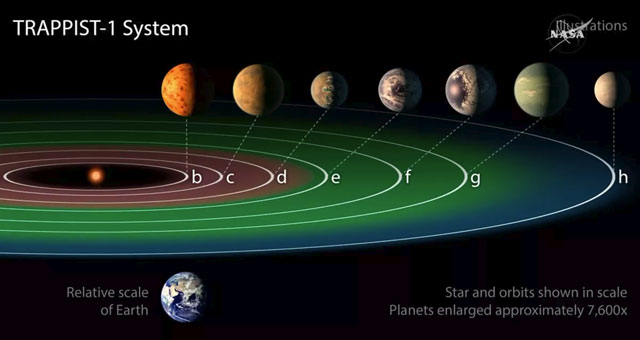
When astronomers eyeball little stars twinkling through their telescopes, they now know for certain that circling around some of them are worlds not unlike our own.
On Wednesday, an international research team using both ground and space-based telescopes announced they’d discovered a solar system 40 light years away with seven Earth-size planets revolving around a small star.
It’s possible that the innermost three planets have “limited regions” with conditions amenable to liquid water, according to the new study published in the journal Nature.
The next three fall more squarely in what astronomers call the habitable zone, where conditions for life, namely temperature and liquid water, are likelier.
The seventh planet circling the system’s dim star is probably too cold for liquid water.
These dim stars, or “ultracool dwarf stars” in the lingo, have a bright side. They’re weak to begin with, so planets passing between them and us will block a greater percentage of light than they can with much larger and brighter stars. That makes them about 80 times easier to detect than if they orbited a Sun-size star.
The finding expands on the announcement last year of three Earth-size planets orbiting this star, called Trappist-1. The team, led by Michaël Gillon of the Université de Liège in Belgium, has since figured out that one of those three planets is actually three separate planets. Two newly found neighbours bring the Trappist–1 system total to seven, Wednesday evening’s announcement revealed.
The first planets outside our solar system, known as exoplanets, were discovered in the mid-1990s. From the earliest findings — Jupiter-sized planets orbiting stars more closely than Mercury circles the Sun — astronomers had to tear up assumptions about what solar systems look like.
Since then, some 3 500 expolanets have been discovered. If 200bn stars are in the Milky Way galaxy, and each of them has at least one planet, that’s billions of possibilities for Earth-like planets.
The rise of exoplanets, the demotion of Pluto to “dwarf planet” a decade ago, and the possibility of a Planet 9 far beyond Neptune all illustrate that, as every year goes by and every new discovery is made, preconceptions about the universe around us are made to be disproved.
When our solar system was the only one we knew of, it was easy to fantasise — on television, film and in our daydreams — that other stars had a menagerie of worlds like ours. What today’s unveiling reveals is that assumption, still no doubt wrong, is not as wrong as we thought.
In the age of big data, it’s common for researchers to dismiss a data set because the sample size is too small. The sample size of exoplanets is still too small. Several thousand planets are documented, compared with the many hundreds of billions of possibilities. The good news is that the Trappist-1 discovery has a huge influence on the odds of finding Earth-size planets elsewhere. If there are seven orbiting a nearby sun, it’s safer to assume that many more are out there that scientists haven’t seen yet.
The exoplanet catalogue, as remarkable as it is, reflects the limitations of tools that astronomers have used at this point. In the next few years, new telescopes will bring advanced power to their investigations. The Transiting Exoplanet Survey Satellite (Tess) will be launched this year and will search for planets around 200 000 or so bright stars. The James Webb Space Telescope, which will be launched next year, is a powerful soup-to-nuts observatory that will enable astronomers to study everything from the early moments of the universe to the formation of planets.
With these observatories, astronomers will be able to better home in on the atmospheres of exosolar planets, if they have any.
These instruments, scientists hope, will help answer the most elementary question of them all: if there are other Earths, are there other living creatures? Are we alone in the universe? “We’ve made a crucial step toward finding if there is life out there,” said Amaury Triaud of the Institute of Astronomy in Cambridge, England.
Excitement over even the most tentative “yes” should be tempered by the fact that scientists aren’t sure how life began on Earth. The hunt for extraterrestrial life is still very young.
Before this discovery, astronomers had one solar system with four rocky planets to study — Mercury, Venus, Earth and Mars. “Now we have seven more that we can study in detail,” Gillon said. “This is not in a few decades. We are doing this now.”
The seventh planet circling the system’s star is probably too cold for liquid water, but probably doesn’t mean definitely. “Three are in the standard habitable zone,” said Julien de Wit, a co-author. “Yet all seven could be ‘habitable’.” — (c) 2017 Bloomberg LP

